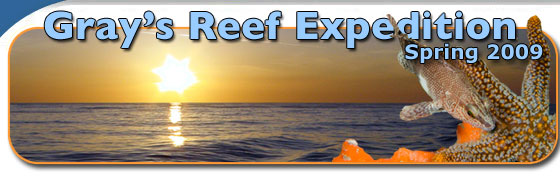Error processing SSI file
|
Marine Debris Monitoring
The coastal region has an increase in population every year. With the increase of population, comes an increase in the recreational uses of the resources along the coast. This can also lead to the increase of pollution to these coastal resources. The marine debris study is focusing on the pollution that makes it to Gray’s Reef National Marine Sanctuary and how it may accumulate there.
In past marine debris studies, the project managers have determined that the majority of the debris found at Gray’s Reef was fishing gear, cans, bottles, and rope. Half of the fishing gear reported was fishing line. These items are small, light weight, and can easily be blown off a boat when in travel. They are also relatively easy to pick up from the bottom when the reef is being “cleaned” by our marine debris monitoring crew. The issue arises with trying to plan when and where do we try to collect the debris. There is just not enough information at this time.
 |
| Marine debris collected on one station during the 2008 Nancy Foster Cruise.
|
The past study has also determined that 95% of the debris can be found along the densely colonized ledges. This is important information since this type of habitat only makes up about 1% of Gray’s Reef. It has been hypothesized that it collects in the densely colonized regions for two possible reasons: 1) fisherman prefer to hang out on these areas due to fish using this habitat and 2) the ledges are structurally complex and have areas where the debris can get stuck.
To better understand how the debris collects on the ledges, scientists have established nine monitoring sites to watch the debris that collects. The sites are either composed of ledges that are tall in height and large in area or ledges of medium height and large area. This is to determine if marine debris accumulates at a different rate on the taller ledges. Also, the tall and large ledges can be found in either high boat traffic areas or in low boat traffic areas. This is to determine if marine debris will be greater in areas that experience a greater degree of boating activity. Along with testing the two hypotheses, scientist should be able to get an average rate of accumulation. This information will be used to determine how often scientists need to visit the reef to remove the debris.
|



